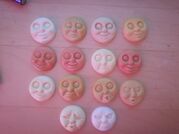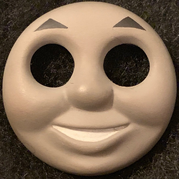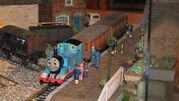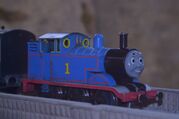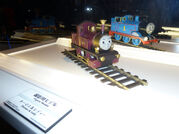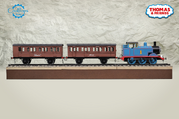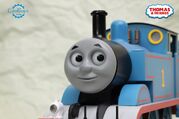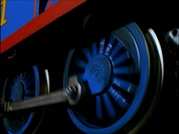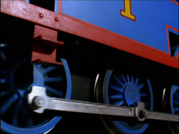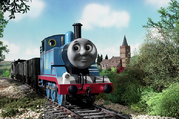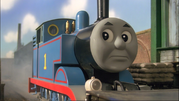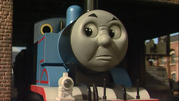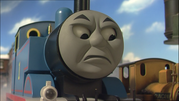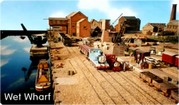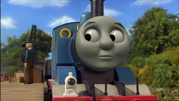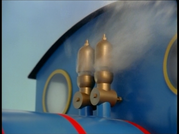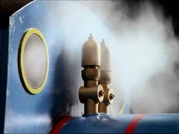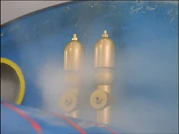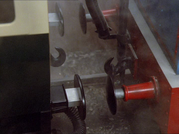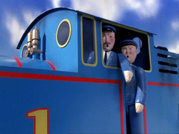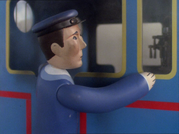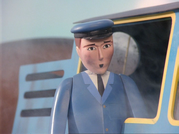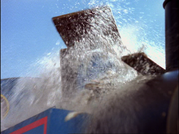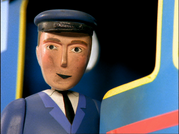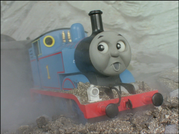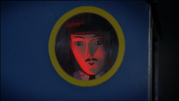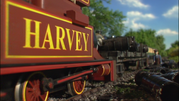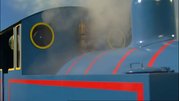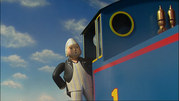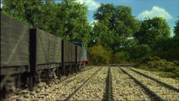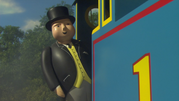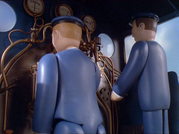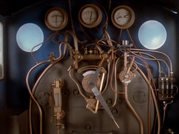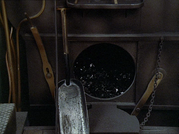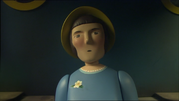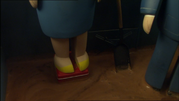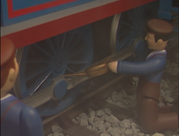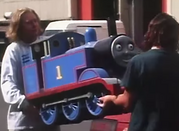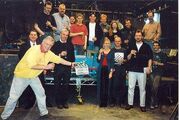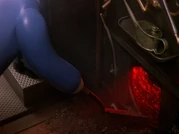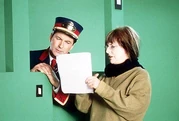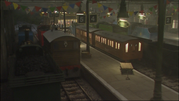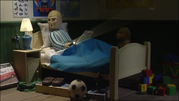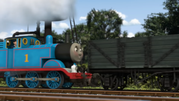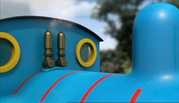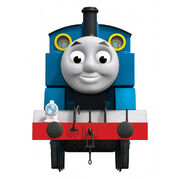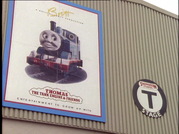
|
Background Information
The Railway Series
Thomas is a fictional standard gauge tank locomotive created by the Reverend W. Awdry. He is the No. 1 engine on the North Western Railway.
He first appeared in The Railway Series book, Thomas the Tank Engine, which was published in 1946. His last appearance was in Thomas and his Friends, published in 2011.
Front of Thomas:
The rear of Thomas:
The Original Thomas
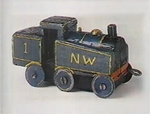
The first Thomas
When the Rev. W. Awdry created Thomas, he existed only as a wooden toy made for his son, Christopher. This engine looked rather different from the character in the books and television series and had side tanks which sloped down to the front of the smokebox. He was painted teal-green with yellow lining and carried the number 1 on his bunker on both sides in yellow and also carried the letters "NW" on his side tanks in yellow. Awdry claimed that this stood for "No Where", but later works would identify the railway Thomas and his friends worked on as the North Western Railway.
For the illustrations of Thomas the Tank Engine, Edmund Ward, then-publisher of The Railway Series, hired illustrator Reginald Payne, who decided to base Thomas on the LB&SCR E2 Class. (Awdry was annoyed that Thomas was not the tank engine he had first drawn, but he was satisfied when Payne explained that he was drawn after a real prototype). Unfortunately, Payne did not receive any credit for his work; it is only since the publication of Brian Sibley's The Thomas the Tank Engine Man that he has received recognition.
Running Plate Problems
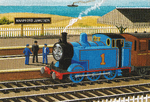
Thomas with his flat footplate
Thomas' running plate was allegedly a source of contention for the Rev. W. Awdry during The Railway Series. As originally drawn, Thomas had a distinctive dip at the front of his running plate, but not on the back. The story goes that to Awdry's eyes, this meant that Thomas's buffers would be at different levels and have operational inaccuracy and impossibility. This seems curious on Awdry's part, as all the artists had drawn Thomas as having an extra-deep rear buffer beam to compensate, this putting the front and rear buffers at the same level.
Be it a matter of taste or inaccuracy, the issue of the running plate had to be settled: thus Thomas's excursion into the stationmaster's house at Ffarquhar was arranged. After his repairs at Crovan's Gate, Thomas returned with a new modified running plate that was flat and level from smokebox to bunker. In the television series, Thomas' running plate was never changed, even after the events of Thomas Comes to Breakfast were adapted. However, his buffers at his front and rear end are measured at the same level, regardless of the dip on his front buffer beam.
Too Much Thomas?
While he may seem innocent enough, poor Thomas created a fair bit of trouble for Christopher Awdry and Egmont Books, publishers of The Railway Series, when the latter started asking for more books about the happy little tank engine. Granted, Thomas was the most popular character in the original books of The Railway Series, but Egmont went too far and thus the problem continues. With the advent of the television series, Egmont started asking for more Thomas and to this day, Thomas has eight volumes of The Railway Series under his undercarriage. Two of the titles have very little to do with Thomas - Thomas Comes Home focuses on the adventures of the branch line engines during Thomas' visit to York, while Thomas and the Fat Controller's Engines only featured one story about Thomas, although he did appear in two of the other three stories. As a result of Thomas' fame, other characters became largely neglected.
Behind the Scenes
The Original Thomas
A wooden push-along toy from the early 1940s is the original Thomas made by the Reverend Awdry out of a piece of broomstick for his son Christopher. This engine looked rather different from the character in the books and television series and was based on a LNER Class J50 with smaller side tanks and splashers. He was painted teal-green with yellow lining and carried the letters NW on his side tanks.
Awdry claimed that this stood for "No Where", but later works would identify the railway Thomas and his friends worked on as the fictional North Western Railway. Christopher Awdry lost this model when he was in the US, although it was recreated for a sizzling promo for the 70th Anniversary.
Awdry's model
The Reverend was happy to endorse Payne's account that Thomas was an LB&SCR E2, although the first Thomas on the Awdry's model railway, from Stuart Reidpath, lacked extended tanks. In the 1979 Thomas Annual, Awdry wrote:
"I bought Thomas in 1948 when I was writing Tank Engine Thomas Again and wanted to start modelling once more after a lapse of some twenty years. Thomas was one of Stewart Reidpath's standard models with a heavy, cast white metal body and was fitted with his "Essar" chassis and motor. Stewart Reidpath is now dead and his motors, let alone spare parts for them, have been unobtainable for years; but Thomas still keeps going! He is, as you might expect from his age, a temperamental old gentleman and has to be driven very carefully indeed".
After Hornby produced the E2 tank in the later 1970s, the Rev. gladly adapted one to take the role of Thomas on Ffarquhar. Additionally prior to modelling Thomas as an E2, Awdry created a model from a LMS 3F Jinty. All three models are preserved at the Narrow Gauge Railway Museum in Tywyn.
Television Series
Thomas's portrayal in the television series was originally faithful to the books, being sometimes stuck-up and arrogant but otherwise kind-hearted and cheeky. When the show started branching away from the books, he was lightened to be cheekier and jolly to appeal to younger children. As the title character, he has the most appearances, speaking roles and episodes dedicated to him in each series.
Voice
When Thomas and the Magic Railroad premiered, the character was voiced by Eddie Glen, who replaced John Bellis as the latter was cut from the early draft when the audience said he made him sound "too old". Both Bellis and Glen portrayed Thomas with a British accent.
Kerry Shale originally auditioned for the character in the UK dub of Hero of the Rails but was ultimately replaced by Ben Small, with Martin Sherman voicing him in the US. Both played Thomas in their respective dubs until 2015 when the producers decided to cast a fresh new voice for Thomas. David Menkin was offered the role of Thomas in the US, but he declined in support of Martin Sherman at the actor's request. Joseph May ultimately succeeded Martin Sherman in the US dub, while John Hasler replaced Ben Small in the UK. Both Hasler and May gave Thomas a higher and bolder-pitched voice, likely to differentiate him from Percy.
Much like Bellis and Glen, Small and Hasler consistently portrayed Thomas with a English accent in the UK, while conversely, Sherman and May portrayed him with an American accent in the US. Ben Small also gave Thomas a notably raspy tone and minor hoarse vocals, which is absent in John Hasler's performance. Both Joseph May and John Hasler were let go from Mattel after the twenty-fourth series when the company rebooted the series once again.
Gauge 1 model
Thomas's original model was custom built to run on gauge 1 track for the Unaired Pilot. The model was built with a Perspex body shell by the model maker, Martin Gill. It was painted using automotive paint and lined with red automotive pinstripe tape with the numbers being custom cut vinyl stickers. The buffers and brake pipes were made by Tenmille. The chassis, which was built from scratch, was never tested before being filmed in front of the camera and proved to be unreliable. The space behind the eye in the body accommodated two little RC servos and a parallelogram arrangement to allow the eyes to be moved by means of a joystick on the remote control. During the pilot, they snagged repeatedly, smoke came out around them, and they were constantly being modified. Often, the eyes were set and locked in a particular direction. It was not unheard of for the static from the power coupling on the track to affect the servos and make the eyes suddenly veer wildly off. The model was equipped with a smoke generator based on a 12V car cigarette lighter, with conventional studio smoke-machine oil dripped on the hot element before each shot – but the heat proved to be sufficient to warp the ABS and Perspex of the engine bodies, so they could not be used for any length of time, a swift charging before a shot allowed a rather feeble smoke effect that sometimes emanated from gaps behind the eyes or at the side of the face-plug. It is currently unknown if the model got warped during filming
The model was then fitted with a new chassis that was sourced from a gauge 1 locomotive made by Märklin, the BR 55. The model was also fitted with a lamp and lamp irons.
The chassis was originally AC powered as this is how the Märklin locomotives were powered. During a refurbishment, his AC motor was replaced by a DC motor to allow for easier running and maintenance.
Ringo Starr holding Thomas' model Wilbert Awdry with Thomas' model Thomas' model specifications Behind the scenes of Thomas in Paint Pots and Queens Christopher Awdry with Thomas' model Britt Allcroft holding Thomas' model Britt Allcroft and Alec Baldwin with Thomas' model Thomas with Percy The perspex model in Thomas and the Magic Railroad The perspex model in the sixth series The perspex model made more appearances in the seventh series than his brass model The perspex model in the eighth series The perspex model in Calling All Engines! The perspex model in the ninth series The perspex model in the tenth series The perspex model's last appearance in Thomas and the Stinky Cheese |
During the production of Thomas and the Magic Railroad, another model of Thomas was built. This was because the original Märklin chassis was very worn at the time and that the original model had been repaired and repainted so many times the crew was afraid some of these imperfections would be seen on the big screen and the model needed to be in top condition for intense use during filming.[1]
The new model was made out of brass and painted in a matte finish. It was equipped with a CNC machined aluminium chassis powered by a DC motor and the bufferbeam details were built from scratch. The Perspex model was also repainted in the matte finish during Thomas and the Magic Railroad and fitted with a new CNC chassis during the sixth series. The Perspex and brass models were used alongside each other for several years.[1]
During the production of The Great Discovery, three more brass models of Thomas were built. This was due to the original Perspex model being 24 years old at this point and the tight filming schedules meant that there was very little room for emergency repairs. By this point, the Perspex model had already been retired from normal use after Calling All Engines!, but would be used in scenes that would damage the brass models.[1] The Perspex model was officially retired completely after the episode, Thomas and the Stinky Cheese.
During the filming of The Great Discovery, a lightweight stunt model of Thomas was made and used for many scenes where Thomas' model would be flying through the air across the ravine or covered in water. This was likely done so that the model could glide lightly in flying scenes and to prevent damage to the model in water scenes with the use of wires and hidden rigs.
The eye mechanism had two servos, one for up and down movement and one for left and right movement. The up and down servo was attached to the body. The left/right servo had a rod attached to the arm, which connected to a bracket. The eyeballs were coupled to the bracket and locked in by the face-plate, so whenever the servos were powered, the eyeballs would move however the crew member desired.
Thirty-eight different facial expressions were sculpted for Thomas, although only thirty-four were used on-screen. The faces were first sculpted in clay and from that resin casts were made of a silicone mould. Some of Thomas's faces were duplicated in case the crew needed a face to look dirty and clean on the same day of shooting. Five of Thomas' screen used and production made faces are now owned by Twitter users ThomasTankMerch and TomsProps.
Thomas' original smiling face that only appeared during the Clearwater Features era (1984-1986) Thomas' unused pilot smiling face that appeared in the first series episode, Down the Mine... (circa 1983, 1985) Thomas' drowsy face that only appeared between the first and the third series (1984-1991) Thomas' yawning face that only appeared in both the first and eighth series (1984, 2004) Thomas' cross face that appeared between the first series and The Great Discovery (1984-2008) ...until its last appearance in the tenth series, having appeared in every series prior, excluding the fourth, fifth series, Thomas and the Magic Railroad and Calling All Engines! (1994-1998, 2003-2006) Thomas' confused/original disgusted face that appeared between the first and eleventh series, excluding the fifth series, Thomas and the Magic Railroad and the tenth series... (1984-1995, 2002-2005, 2007) ...but did appear in a deleted scene of the fifth series episode, Snow... (1998) ...as well as the tenth series Learning Segment, Help from Your Friends (2006) ...then later had the eyebrows modified to resemble a nervous face in the second series episodes, The Runaway, Better Late Than Never and Thomas Comes to Breakfast... (1986) ...and was reverted back to its original appearance during the end of Thomas Comes To Breakfast and the third series all the way... (1986-1991) ...until the end of the model era, having appeared in every series prior, excluding the fifth and seventh series and Thomas and the Magic Railroad (1995, 2002, 2004-2008) ...as well as a deleted scene of the second series episode, Ghost Train... (1986) ...and did not appear on-screen until the third series with the eye socket size reduced and the eyebrows modified to resemble a concerned face all the way until the end of the model era (1991-2008) ...which later gained a bucktooth during The Britt Allcroft Company era... (1991-1998) ...until it disappeared in Thomas and the Magic Railroad all the way until the end of the model era (2000-2008) Thomas' original wincing face that only appeared between the first series and Thomas and the Magic Railroad (1984-2000) ...and did not appear on-screen again until it reappeared in Thomas and the Magic Railroad all the way until the end of the model era, excluding the sixth series (2000, 2003-2008) ...which later gained teeth to become his original grinning face for publicity photos after production of the second series was complete... (1987, 1988) ...until it last appeared in the sixth series, having appeared in every series prior, excluding the fourth series... (1991, 1998, 2002) ...but did appear on the Thomas & Friends - 'The Big Live Tour' poster (2003) ...and did not appear on-screen again until the sixth series where it gains some teeth during production of the third series...[2] (1992-2002) ...and then some more during production of the HiT Entertainment model era (2004-2008) ...which was never used in the model era, but was designed in 3D to appear in The Great Festival Adventure PC game (1999) ...until it later gained some teeth to become his current grinning face in the sixth series... (2002) ...and was later recasted during the seventh series all the way until the end of the model era, excluding the tenth series... (2003-2005, 2007-2008) ...but did appear in a promotional image of the tenth series episode, Follow that Flour! (2006) Thomas' confident face that appeared between the third and sixth series, excluding Thomas and the Magic Railroad... (1991-1998, 2002) ...until it was recasted during the seventh series all the way until Calling All Engines!(2003-2005) and last appeared in the eleventh series, having appear in every series prior, excluding the fifth, sixth, seventh, ninth, and tenth series... (1998, 2002-2006) Thomas' current smiling face that appeared between the third and twelfth series, excluding the fifth series... (1991-1995, 2000-2008) Thomas' unused third series jolly face that only appeared on-screen in the fifth series episodes, Something in the Air, Rusty and the Boulder and Snow (1991, 1998) Thomas' unused third series alarmed face that only appeared between the fifth and seventh series, excluding Thomas and the Magic Railroad (1991, 1998, 2002, 2003) Thomas' unused third series anxious face that was designed in 3D in the Trouble on the Tracks PC game... (1991, 2000) ...and finally appeared on-screen during the eighth series and Calling all Engines!... (2004-Early 2005) ...until it disappeared during the ninth series all the way until the end of the model era, excluding The Great Discovery (Mid 2005-2008) Thomas' unused third series outraged face that only appeared on-screen once in the tenth series episode, Topped Off Thomas (1991, 2006) ...which later had his mouth raised up slightly in Thomas and the Magic Railroad, all the way until the tenth series... (2000-2006) ...before it last appeared in The Official BBC Children in Need Medley music video (2009) Thomas' depressed face that only appeared between the fourth and eleventh series, excluding Thomas and the Magic Railroad (1994-1998, 2002-2007) Thomas' upset face that first appeared in the fourth series episode, Paint Pots and Queens... (1994) ...and did not appear on-screen again until the eighth series all the way until the eleventh series (2004-2007) ...until he had his eye socket size reduced in Thomas and the Magic Railroad all the way until the eleventh series (2000-2007) ...and did not appear on-screen again until the tenth series, all the way until the end of the model era (2006-2008) Thomas' new wincing face that only appeared between the seventh series and The Great Discovery (2003-2008) Thomas' new disgusted face that only appeared in the eleventh series episode, Thomas and the Stinky Cheese (2007) Some of Thomas' faces during production of the third series (1991) [Note: The unused frustrated face next to his sad face] Thomas' unused elderly face made by Jeremy King as a joke to David Mitton sometime before or during filming of the fourth series[2] (1994) Photo one of Thomas' faces during production of the fourth series (1994) [2] [Note: The unused snarling face is between his sleeping and depressed face, and his unused frustrated face is on the bottom left corner] Photo two of Thomas' faces during production of the fourth series (1994)[2] [Note: The unused elderly face on the left bottom between his shocked face and second original smiling face and the jovial face on the top right corner] Page one of Thomas' faces during production of the sixth series (2002)[3] [Note: Two of Thomas' unused facial expressions; snarling and frustrated, on the last two left bottoms] Page two of Thomas' faces during production of the sixth series (2002)[3] [Note: The unused jovial face on the bottom left] Page three of Thomas' faces during production of the sixth series (2002)[3] Page one of Thomas' face reference sheet taken during the production of Series 12, courtesy of TomsProps on Twitter[4] Page two of Thomas' face reference sheet taken during the production of Series 12, courtesy of TomsProps on Twitter[4] Page three of Thomas' face reference sheet taken during the production of Series 12, courtesy of TomsProps on Twitter[4] Page four of Thomas' face reference sheet during production of the twelfth series, courtesy of TomsProps on Twitter |
The twelfth series marked the beginning of the show's transition into CGI and the characters' faces were animated through CGI with the aid of motion-capture animation. The physical models's moulded faces were replaced by white targets with triangles to fix a computer-animated face in post-production. Thomas's resin faces were only used in background shots.
Thomas has been seen mistakenly wearing Percy's tired face mask in the two first series episodes, Thomas Goes Fishing and Thomas and Bertie.
Percy has also been seen mistakenly wearing Thomas's tired face mask in the third series episode, Diesel Does it Again and the eighth series episode, Percy's Big Mistake.
Thomas's gauge 1 models had gone through several aesthetic changes in the television series:
- Series 1:
- He has a realistic brake pipe which is tilted down to keep it from touching his face.
- He shares his footstep design with Percy.
- Series 2:
- He gains a smaller brake pipe on both his front and back ends.
- The blue supports under his whistle become gold.
- Series 3:
- His footsteps become smaller.
- After Trust Thomas, the lining on the back of Thomas's bunker is removed.
- His shocked face gains a bucktooth.
- Series 4:
- His coupling rod bolts became blue.
- Thomas and the Magic Railroad:
- His paint was given a matte finish.
- He sits higher on his chassis. (brass model)
- His eyebrows became thicker.
- The gold supports under his whistle revert to their original blue colour.
- His front windows are now the same height as his back windows. (brass model)
- His cab doors are open for most of the film.
- The bucktooth on his shocked face disappears for the rest of the model era.
- His funnel becomes thinner. (brass model)
- His dome becomes more flat at the top. (brass model)
- His whistle sound changed which sounded pretty similar to his original one.
- His side windows are not rounded on the corners. On his perspex model, the lining became square while the window itself was still rounded.
- His coupling rod bolts became silver again.
- Series 6:
- He regained his original whistle sound.
- His coupling rod bolts became blue again.
- Series 9:
- The teeth on his anxious face disappear for the rest of the HiT Entertainment model era.
- Series 11:
- His whistle is lowered, thus placing it closer to the boiler. This was first seen in the episode Thomas and the Big Bang.
- The funnel on his perspex model becomes even thicker.
- Series 12:
- On his CGI face, his eyes were enlarged, his eyebrows were thickened, his mouth was smaller and he had a larger nose.
During a few shots in the first series episodes, Thomas and Gordon and Thomas' Train, and the second series episodes, Thomas, Percy and the Coal, Old Iron and A Close Shave, his headlamp has an additional handle, which later disappeared for unknown reasons.
Thomas' original brass model is on display at the Hara Model Railway Museum. It has previously been on display at Nitrogen Studios. One of the three Thomas's brass models made during the production of the Great Discovery is on display at Drayton Manor, while the other two are on display at two different Explore the Rails events.
In 2019, a faithful replica prop was made by CoolProps in Japan and sold to the public. They used the original models located at the Hara Model Railway Museum in Japan for reference.
Gauge 3.5 model
During the fifth series, the production team was having discussions about scaling up the models to gauge 3.5 for Thomas and the Magic Railroad. Models of Thomas and Percy were built to this scale for testing, but the production team ended up deciding to stick with the gauge 1 models due to budget reasons. Thomas' model was used for test shots accompanied by a green screened Mr Conductor. The model was later put to use for close-up shots of his wheels, which can be seen in some Music Videos.
Thomas' model would later be used alongside the models of the Sodor Construction Company vehicles, which had to be larger than the gauge 1 model to fit in all the components required for filming.
Eight different facial expressions were created for the model. The faces were first sculpted in clay and from that resin casts were made of a silicone mould.
The model was made from brass. The wheels and chassis were custom machined (CNC). The model was track powered, so pickup contacts were attached to the metal wheels, which ran into the motor to power it. The electricity ran from the track to the wheels/pickup contacts and went into the motor to power him. The model was also fitted with a smoke unit.
The eye mechanism had two servos, one for up and down movement and one for left and right movement. The up/down servo was attached to the body. The left/right servo had a rod attached to the arm, which connected to a bracket. The eyeballs were coupled to the bracket and locked in by the face-plate, so whenever the servos were powered, the eyeballs would move however the crew member desired.
The model was used in the sixth series, Jack and the Sodor Construction Company and The Great Discovery. It also appeared in some scenes in the eighth series episodes, Gordon Takes Charge, Fish, the Calling All Engines! special and the tenth series episodes, Thomas' Frosty Friend and Topped Off Thomas.
Thomas' gauge 3.5 model has gone through several aesthetic changes in the television series:
- Series 5:
- The model's appearance differs from that of the gauge 1 model; this includes:
- The brake pipe, funnel and buffers increase in size.
- His lamp becomes much more simplified in shape and increases in size.
- Thomas gains a hole on the left side of his running board.
- The counterweight on Thomas's middle wheel changes position, much like his basis.
- The coupling rods become much chunkier.
- His footsteps are painted red and have two additional rivets above them.
- The model's appearance differs from that of the gauge 1 model; this includes:
- Series 6:
- His footsteps are repainted blue and the additional rivets disappear.
- Jack and the Sodor Construction Company:
- The lamp is remade to be closer to that on the gauge 1 model.
The model is currently on display in Japan at the Hara Model Railway Museum. It had previously been on display at Thomas Town.
Gauge 3 model
A gauge 3 model of Thomas was built in the ninth series to be used alongside the large-scale models of the Skarloey Railway engines, which had been used since the fifth series for ease of filming and reliability.
The model was made from brass. The wheels and chassis were custom machined (CNC). The model was track powered, so pickup contacts were attached to the metal wheels, which ran into the motor to power it. The electricity ran from the track to the wheels/pickup contacts and went into the motor to power him. The model was also fitted with a smoke unit.
The eye mechanism had two servos, one for up and down movement and one for left and right movement. The up and down servo was attached to the body. The left/right servo had a rod attached to the arm, which connected to a bracket. The eyeballs were coupled to the bracket and locked in by the face-plate, so whenever the servos were powered, the eyeballs would move however the crew member desired.
Eight different facial expressions were created for the model, but only seven were used on-screen. The faces were first sculpted in clay and from that resin casts were made of a silicone mould.
In the twelfth series, the physical models's moulded faces were replaced by white targets with triangles to fix a computer-animated face in post-production.
The gauge 3 models were used in Series 9-12 and The Great Discovery. The model was put on display at the British Museum during the 70th Anniversary.
Close-up model
A close-up model of Thomas was built to be used for scenes where he had to interact with the close-up scale figures. Unlike most close-up models, the one for Thomas was built as a complete engine.
The cab was made in pieces so it was able to be dismantled and resembled for use of interior shots if required. The model also emitted steam when required, especially during closeup whistle shots.
Two faces were sculpted for Thomas. The close-up of Thomas's happy face was also used on the close-up of Duck in the second series episode, A Close Shave. Also, the close-up of his sad face is used in another episode, Thomas Comes to Breakfast.
The model was also equipped with an eye mechanism. The eye mechanism had two servos, one for up and down movement and one for left and right movement. The up/down servo was attached to the body. The left/right servo had a rod attached to the arm, which connected to a bracket. The eyeballs were coupled to the bracket and locked in by the face-plate, so whenever the servos were powered, the eyeballs would move however the crew member desired.
Thomas' close-up model has gone through several aesthetic changes in the television series:
- Series 1:
- The model has many additions which the gauge 1 model lacks; these include:
- Seven rivets along each side of his cab roof.
- Rivets around each end of his smokebox.
- His tank filler caps gain hinges and handles.
- He has rivets along his front and rear buffer beams as well as the back of his bunker.
- His front buffer holds are painted black and based on those of wagons rather than those on Thomas' model.
- The model has many additions which the gauge 1 model lacks; these include:
- Series 2:
- His front buffers are changed to more closely resemble those on his gauge 1 model.
- His front buffer holds are painted red to match his rear ones.
- Series 3:
- The seven rivets along each side of his cab roof disappear.
- He gains two screws on each side of his cab beneath the porthole windows.
- Series 4:
- The screws he gained in the third series disappear.
- Series 5:
- The bottom halves of his whistles are repainted from blue to gold.
- Series 11:
- The rivets around his smokebox disappear.
- Whistles
- Buffers
- Outside
- Inside
- Series 9-12 TV Opening/Closing
- Behind the Scenes
In the second series episode, Old Iron, Thomas's close-up model's bufferbeam (with the lamp removed) was re used as James's bufferbeam as his close-up model at the time was just his cab and tender and did not have a front bufferbeam. It was also reused for Percy in the second series episode, Percy and Harold and the third series episodes, Percy's Promise and Percy, James and the Fruitful Day as his close-up model at the time was an exterior shell and did not have cab controls.
In the second series episode, A Close Shave, Thomas's close-up happy face was reused for Duck as his face.
Life-size model
During the production of Thomas and the Magic Railroad, a large facsimile of Thomas's cab, tanks and boiler were built for the cab shots featuring him. The scenes were filmed with a green screen method, so the life-sized model and the background for filming were green.
Thomas's Poster
As for dressing for the large scale set, several posters of Thomas was made. The posters appeared in the ninth and tenth series at Knapford station toy shop and the Children's bedroom.
CGI model
In 2009, the series introduced Computer-Generated Imagery (CGI) as a replacement for the show's long-standing live-action models. Thomas was recreated from scratch in CGI by Nitrogen Studios. His model was "hand-sculpted" in Maya, a 3D animation and modelling software. However, test footage was created by Stardust Pictures as they recreated scenes from Thomas and the Stinky Cheese. Photographs of Thomas' gauge 1 model were used for reference. According to Greg Tiernan, every detail of the original television series models for each character is carefully reproduced in the CGI model. The models are subjected to many rounds of review before they are submitted to HiT Entertainment for final input and approval.
A new green livery was skinned on the model for 2015's The Adventure Begins.
In 2016, a new streamlined render of Thomas was made for The Great Race by Arc Productions. The render was completely made from scratch, the wheels, side rods and face being the only reused parts. The render was modified by Jam Filled Toronto for 2018 special, Big World! Big Adventures!; most notably, gaining a new livery resembling Thomas' current one and a visor over his eyes. Both versions were only used in fantasy scenes in their respective specials.
Thomas has had modifications throughout the CGI era. These include:
- Hero of the Rails:
- Thomas's cab is open.
- He becomes smaller.
- His number 1 became slightly smaller and the red lining became thicker.
- Thomas gains visible internal motion.
- His whistle sound becomes softer in pitch.
- His body and smokebox saddle become thinner and his smokebox and boiler are smaller.
- The slope on the back of his running board is not tapered.
- The Adventure Begins:
- The red lining on the back of Thomas's bunker returns.
- His side rods become silver.
- He temporarily gained a new livery.
- Journey Beyond Sodor:
- A bunker hatch is added in his cab.
- Series 23:
- He gained rivets across his buffer beam front and sides, side tanks top and sides, around his cab side windows, on his coupling hook and buffer bases, on his bunker sides and rear, on the sides of his frames, along the sides of his roof and around his smokebox.
- He now has handrails on either side of his cab entrances.
- He now has a step on the front of each of his side tanks.
The following pantone colours are used on Thomas's CGI model:
- PMS 116 (yellow)
- PMS 299 (blue)
- PMS 428 (white)
- PMS 485 (red)
- PMS 873 C (gold)
- PMS 877 C (silver)
Thomas in Popular Culture
Since his debut in The Railway Series and the launch of the television series, Thomas has become an extraordinarily popular character, appearing in over twenty series and starring in several direct-to-video films. Because of his popularity, Thomas has even appeared or has been mentioned in other popular shows and films, as well as appearing in many public events too.
During the Thomas the Tank Engine & Friends production, a large Thomas signboard was installed on the T-stage in Shepperton Studios where they were filmed.
Thomas appeared in the 2009 Children in Need charity single produced by the BBC. In it, he was voiced by Ringo Starr, the former narrator of the television series.
In 2014, a balloon of Thomas was launched for the Macy's Thanksgiving Day Parade to celebrate the upcoming 70th Anniversary of The Railway Series and he continued to appear in the parade for the next two years. Thomas was also featured in the Toronto Santa Claus parade alongside Percy and Rosie on 15th November 2015.
In the 2015 Marvel film Ant-Man, Thomas made a cameo appearance in the form of a model train that plays a pivotal role in the film's climactic battle sequence. Bachmann HO scale models of him, Annie, Clarabel and Emily's coaches were used for the film, while a large scale model was used for close-up shots, with the face digitally altered to resemble the one on the HO scale model for continuity.
In the Robot Chicken parody sketch Blow Some Steam, Thomas was voiced by Harry Potter actor, Daniel Radcliffe. His Bachmann model was used throughout the sketch.
There have been plans announced to rebuild Number 110, the last surviving E2 class locomotive since 2012, with wheel splashers, extended tanks, a larger bunker and a blue livery, all much like Thomas himself.
Voice Actors
- John Bellis (Thomas and the Magic Railroad; original work-prints only)
- Edward Glen (Thomas and the Magic Railroad)
- Ringo Starr (UK; 2009 Children in Need charity single)
- Ben Small (UK; Hero of the Rails - eighteenth series)
- Kerry Shale (UK; Hero of the Rails; original cut only)
- John Hasler (UK; The Adventure Begins - twenty-fourth series)
- Martin Sherman (US; Hero of the Rails - eighteenth series)
- Joseph May (US; The Adventure Begins - twenty-fourth series)
- David Menkin (US; Declined)
- Hugolin Chevrette-Landesque (French speaking Canada; Thomas and the Magic Railroad)
- Fabrice Trojani (France and French speaking Canada; sixth series onwards)
- Keiko Toda (Japan; first - eighth series)
- Kumiko Higa (Japan; Calling All Engines! onwards)
- Espen Sandvik (Norway; Hero of the Rails - Tale of the Brave)
- Martin Lange (Norway; eighteenth series onwards)
- Marco Vivio (Italy)
- Víctor Ugarte (Latin America; Thomas and the Magic Railroad)
- Irwin Daayán (Latin America; Thomas and the Magic Railroad; TV Version)
- Javier Olguín (Latin America; Hero of the Rails - The Great Race, excluding Thomas the Babysitter and the twentieth series)
- Héctor Cuevas (Latin America; Thomas the Babysitter, twentieth series - Ace's Brave Jump, excluding The Great Race)
- Marc Winslow (Latin America; Nia's Bright Idea onwards)
- Luis Leonardo Suárez (Latin America; singing voice)
- Marcel Collé (Germany; Thomas and the Magic Railroad)
- Christian Stark (Germany; twelfth series onwards)
- Dirk Bach (Germany; Audio Books only)
- Janusz Zadura (Poland)
- Pepijn Koolen (The Netherlands; Thomas and the Magic Railroad)
- Jürgen Theuns (The Netherlands; Hero of the Rails onwards)
- Simcha Barbiro (Israel; Thomas and the Magic Railroad)
- Doriel Zohar (Israel)
- Caspar Phillipson (Denmark)
- Daniel Figueira (Brazil; Hero of the Rails onwards)
- César Díaz Capilla (Spain)
- Juha Varis (Finland; Hero of the Rails onwards)
- Richard Balint (Romania)
- Haris Grigoropoulos (Greece)
- Csore Gabor (Hungary)
- Gia Trí (Vietnam)
- Prokhor Chekhovskoy (Russia)
- Pavel Tesař (Czech Republic; Hero of the Rails - seventeenth series)
- Jan Kalous (Czech Republic; Tale of the Brave onwards)
- Shin Yong-u (South Korea; twelfth (EBS) - twenty-fourth series)
- Jo Yeon-u (South Korea; Tale of the Brave - Journey Beyond Sodor)
- Nick Atkinson (Sweden; Hero of the Rails onwards)
- Steffan Rhys (Wales)








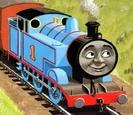
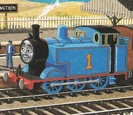

























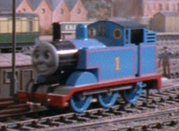









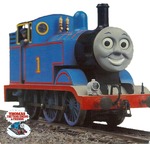















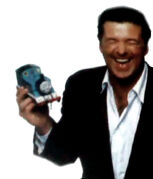









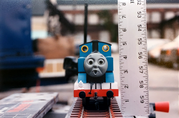
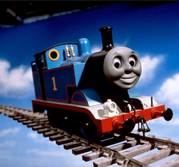




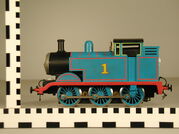

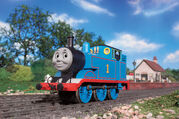





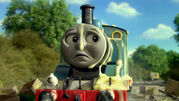




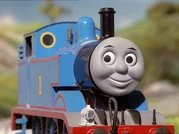








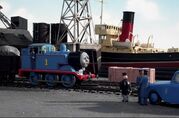



















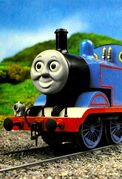



![ThomastheJetEngine72.jpg (269 KB) ...and did not appear on-screen again until the sixth series where it gains some teeth during production of the third series...[2] (1992-2002)](https://static.wikia.nocookie.net/ttte/images/b/bb/ThomastheJetEngine72.jpg/revision/latest/scale-to-width-down/179?cb=20200504065735)

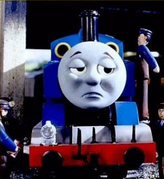







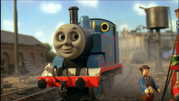




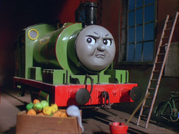
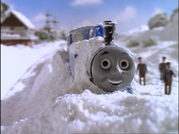

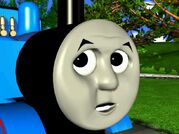



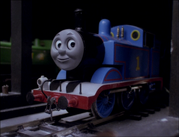











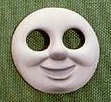
![Thomasunusedelderlyface.png (124 KB) Thomas' unused elderly face made by Jeremy King as a joke to David Mitton sometime before or during filming of the fourth series[2] (1994)](https://static.wikia.nocookie.net/ttte/images/5/56/Thomasunusedelderlyface.png/revision/latest/scale-to-width-down/179?cb=20201111140910)
![Series4FaceReference-Thomas-Photo1.jpg (820 KB) Photo one of Thomas' faces during production of the fourth series (1994) [2] [Note: The unused snarling face is between his sleeping and depressed face, and his unused frustrated face is on the bottom left corner]](https://static.wikia.nocookie.net/ttte/images/6/69/Series4FaceReference-Thomas-Photo1.jpg/revision/latest/scale-to-width-down/179?cb=20200325124212)
![Series4FaceReference-Thomas-Photo2.jpg (736 KB) Photo two of Thomas' faces during production of the fourth series (1994)[2] [Note: The unused elderly face on the left bottom between his shocked face and second original smiling face and the jovial face on the top right corner]](https://static.wikia.nocookie.net/ttte/images/0/00/Series4FaceReference-Thomas-Photo2.jpg/revision/latest/scale-to-width-down/179?cb=20200325124845)
![ThomasFaceMasks1.jpg (1.98 MB) Page one of Thomas' faces during production of the sixth series (2002)[3] [Note: Two of Thomas' unused facial expressions; snarling and frustrated, on the last two left bottoms]](https://static.wikia.nocookie.net/ttte/images/7/79/ThomasSeries6FaceReferencesPage1.jpg/revision/latest/scale-to-width-down/130?cb=20190921145509)
![ThomasFaceMasks2.jpg (2.02 MB) Page two of Thomas' faces during production of the sixth series (2002)[3] [Note: The unused jovial face on the bottom left]](https://static.wikia.nocookie.net/ttte/images/e/ee/ThomasSeries6FaceReferencesPage2.jpg/revision/latest/scale-to-width-down/130?cb=20190921145548)
![ThomasFaceMasks3.jpg (1.56 MB) Page three of Thomas' faces during production of the sixth series (2002)[3]](https://static.wikia.nocookie.net/ttte/images/5/57/ThomasSeries6FaceReferencesPage3.jpg/revision/latest/scale-to-width-down/130?cb=20190921145608)
![ThomasFaceReference1-Series12.jpg (1.2 MB) Page one of Thomas' face reference sheet taken during the production of Series 12, courtesy of TomsProps on Twitter[4]](https://static.wikia.nocookie.net/ttte/images/9/95/ThomasFaceReference1-Series12.jpg/revision/latest/scale-to-width-down/179?cb=20191221191445)
![ThomasFaceReference2-Series12.jpg (1.3 MB) Page two of Thomas' face reference sheet taken during the production of Series 12, courtesy of TomsProps on Twitter[4]](https://static.wikia.nocookie.net/ttte/images/6/64/ThomasFaceReference2-Series12.jpg/revision/latest/scale-to-width-down/179?cb=20191221191721)
![ThomasFaceReference3-Series12.jpg (1.23 MB) Page three of Thomas' face reference sheet taken during the production of Series 12, courtesy of TomsProps on Twitter[4]](https://static.wikia.nocookie.net/ttte/images/1/1d/ThomasFaceReference3-Series12.jpg/revision/latest/scale-to-width-down/179?cb=20191221192143)


